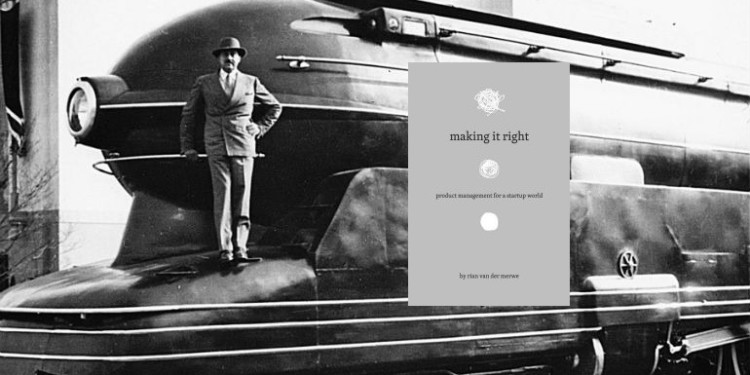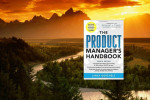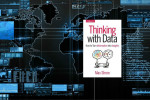Making it Right

Making It Right: Product Management For A Startup World by Rian van der Merwe
This is a great, compact overview of product management. van der Merwe divides the book into three sections: product management roles and responsibilities, product planning, and execution. This is one of the few books that discusses product roadmaps at length. van der Merwe includes a lot of insights into product design and puts the decision making process into clear frameworks.
The book’s two major sections, product planning and execution, intersect in what van der Merwe calls strategic product management. He believes that the product management community lacks “the patience and frameworks required to make sure we understand users before we start building products for them.” Moreover, there is a lack of established tools and frameworks by which to execute on the ideas generated in the planning phase. This book brings together those two halves of product management through immediately applicable principles and frameworks.
Product Management
The product manager’s mission is to achieve success by meeting user needs through the continuous planning and execution of digital product solutions.
A product manager has three primary areas of focus: 1) making the business successful; 2) deeply understanding the target market and the needs of the company’s customers which translates into the best possible customer experience of the product; and 3) driving the continuous planning and execution cycles in a sustainable way to support business growth and market needs.
Key activities span the range from opportunity identification to product strategy and roadmap development, leadership of product teams, evangelizing the product internally, and representing customers throughout the organization.
It is vastly easier to identify market problems and solve them with technology than it is to find buyers for your existing technology.
van der Merwe tackles the question “why do we need product managers?” by pointing out that product managers ensure a market-driven approach to product development and ensure a faster “time-to-everything” by providing repeatable and successful frameworks and processes for getting products into the hands of customers.
Great product managers will be “I-shaped people” who blend vision, strategy, and execution into successful products through a keen understanding of the needs of those for who they are building solutions. The top of the I (“head in the clouds”) contains the visionary and strategic elements of the job while the bottom (“feet on the ground”) encompasses the ever-important ability to actually ship awesome products.
One of the hardest skills for a PM to learn is to take their own emotions and feelings out of the equation when it comes to decision-making. Yes, a lot of gut feeling goes into a product vision, but that cannot be based on personal preferences or preconceived ideas.
Product Planning
van der Merwe’s product planning framework begins with user needs, business needs, and technical needs, all of which feed into product discovery. Through problem frame diagrams, personas, and customer journey maps, product discovery generates a strategic product plan which then informs the prioritization and filtering of ideas. The product roadmap is the result of the prioritization process.
User needs can be gathered through a number of approaches: exploratory research, design research, and assessment research. Business needs revolve around strengthening and optimizing the business model which fuels the company’s growth and profitability. Understanding the dynamics of business model elements is a key skill for product managers to master. van der Merwe summarizes this as pursuing good revenue streams and avoiding bad revenue streams. In the realm of technical needs, the book makes a valuable distinction between unintentional technical debt and intentional technical debt. As with any type of debt, technical debt must be paid off so it’s important to understand whether it is the deliberate type or not.
When discussing prioritization, van der Merwe notes that product life cycle stage, level of user engagement, and financial state of the business are key factors when assessing user, business, and technical needs. In a user acquisition phase, user needs will outweigh business and technical needs while during a phase in which organic business growth is high, business needs and revenue growth will take precedence.
Customer Journey Maps
Journey maps are visual representations that help summarize research, highlight and prioritize user needs and opportunities, and get buy-in from stakeholders.
Customer journey maps are a key artifact during product discovery. They consist of:
Unique selling points for the product that need to be communicated to audiences.
Journey stages and model which is a visual representation of the entire customer lifecycle.
Questions a member of the target market will typically ask during their journey.
Takeaways and key principles which summarize the items above.
A content plan which address the questions. This item is more relevant for websites than other software products.
The Design Process: variation and iteration
Effective product development moves between variation (finding the right product or product variant to produce) and iteration (incrementally finding the right design for the selected product direction). Generating a lot of ideas enables a wider view of options, which then makes for better decisions because a broader scope of alternatives is under consideration.
Product Roadmaps
We can change direction as many times as we want. This doesn’t make it a useless exercise: it means that you build on past successes, don’t make the same mistakes twice, and keep making measurable progress since you can see from where you came.
Roadmaps are a thorny issue for all product managers. On the one hand, the can generate excitement and paint a vision of the future; on the other, they can paint you into a corner and set you up for disappointing customers. van der Merwe posits two principles for product roadmaps:
Roadmaps are flexible guidelines which will change frequently
With a Product Council, roadmaps reflect the priorities of the entire company
If you’re serious about frequent incremental change as opposed to large redesign projects, you can’t live without a roadmap because you’ll have no idea how far you’ve gone, what you still need to do, and what’s more important than something else.
Key elements of an effective roadmap are: absolute priority, maximum ten word summary, maximum 50 word description, project contacts, business impact, estimated level of effort, and a link to the functional specification. Dates belong on a release plan.
Problem Definitions
van der Merwe introduces the concept of a problem story (as opposed to the traditional user story)
[user] has [problem] when [trigger]
The overall problem definition must clearly define the target user, the problem to be solved, the circumstances under which the problem occurs, and contextual information.
The book includes several chapters on the design process which takes the problem definition, creates alternatives, measures effectiveness, and iteratively redesigns. van der Merwe also provides tips on justifying the cost of usability testing.
Specifications
One key deliverable of van der Merwe’s framework is a functional specification. Unlike tree-killing documents of the past, he recommends a visible and flexible which supports collaboration and incremental knowledge gathering about the problem space. The contents of this document include: project summary, clinks for future reference (in the likely event that decisions made by the product team are lost in the mists of time), problem definition, business goals, success metrics, competitive analysis, and project scope. One important section of this document is the identification of risk and impact on other active projects and functional areas in the company. Customer journey maps, sketches, wireframes, and prototypes should also be included.
Makers and Managers
In the section about team and time management, van der Merwe points out that makers (people who must solve problems and write code) need large chunks of uninterrupted time, while managers (people who primarily manage information and communication) operate in hourly chunks throughout the day. When those cultures meet, it is typically the makers who suffer.
Your first 90 days as a product manager
van der Merwe finishes the book with advice on what to do when you land a new product management job. His advice: learn about the product, the market, and company culture. Understand the company’s business model, value proposition, and revenue streams. Meet customers and understand key themes: positive and negative assessments of your product. Company culture(s) are also important to understand as a product manager will need to navigate various teams to effectively get products out to market.
In the next 30 days, a strategic product plan should be developed. Start with a product discovery workshop, develop personas and customer journeys, prioritize ideas, start building a roadmap, identify success measures, and establish key product processes.
For the final 30 days, begin executing on your plan. Pick a problem with a well scoped problem with measurable metrics. Iterate on that problem and then
…get into the rhythm of building great products: constant learning, constant testing, constant dreaming, constant building. There will never be a dull moment.






